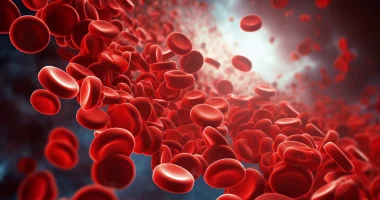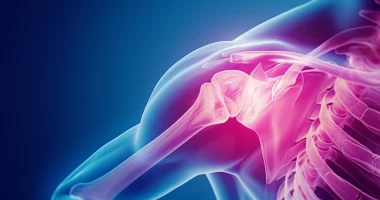Bisphosphonate-related osteonecrosis of the jaw (BRONJ)
Definition
Osteonecrosis of the jaw is the necrosis and denudation of the bone area caused by prolonged antiresorptive therapy. The pathology is a drug-induced complication arising from treatment with bisphosphonates, monoclonal antibody correctors of bone metabolism. The condition manifests by loosening teeth, denudation of the jawbone, severe pain, and difficulty eating. Radiography and CT of the jaw and histologic examination of bone biopsy specimens are used for diagnosis. Treatment includes antibiotic therapy, surgical resection of the affected areas of bone, and experimental methods.
General information
Osteonecrosis of the jaw is a relatively rare disease that affects 1-2% of people on long-term therapy with bisphosphonates and other drugs against bone destruction. Some authors believe that against prolonged bisphosphonate therapy, the prevalence of the disease reaches 8-27%. The risk of developing pathology directly correlates with the type, dose, and duration of drug administration. More frequent use of potentially toxic drugs and more frequent cases of polypragmasy increase the relevance of osteonecrosis of the jaw and require dentists and surgeons to develop adequate treatment programs.
Reasons
A key etiologic factor in osteonecrosis is the use of drugs that affect the metabolism of cartilage and bone tissue. This group includes bisphosphonates, the main drugs used in myeloma disease, bone metastases of malignant tumors, and severe variants of osteoporosis. Recombinant medicines based on monoclonal antibodies that inhibit the activity of osteoclasts have become a less frequent cause.
The likelihood of complications increases with prolonged treatment with the drugs mentioned above. In the risk group are menopausal women and the elderly, who are much more likely to encounter progressive osteoporosis and receive appropriate medications. The following factors can act as a trigger for pathologic changes in the bones of the jaw:
- Dental manipulation. Tooth extraction, implantation of posts, and placement of crowns trigger necrosis of the jaw. The risk increases if the patient does not inform the dentist about taking BF, which makes it impossible for the doctor to choose more gentle treatment options or postpone a planned intervention.
- Improper oral hygiene. Any trauma to the jaws increases the risk of osteonecrosis. Regularly using stiff brushes, sloppy brushing, flossing, and toothpicks can lead to the development of the disease.
- Infections of the oral cavity. Periodontal pathogens, such as Porphyromonas, Prevotella, Actinomyces, and others, play a significant role in the initiation and progression of osteonecrosis. Staphylococci, streptococci, and saprophytic Neisseria saprophytica also play a certain role in the progression of inflammation.
- Associated diseases. The probability of jaw osteonecrosis increases in the presence of anemia, thrombocytopenia,coagulopathy, and infectious diseases. All of these conditions are typical of cancer patients receiving bisphosphonate therapy, so there are often several risk factors in one person.
Symptoms of osteonecrosis of the jaw
According to the clinical course, the disease has four consecutive stages. At stage zero, there are no signs of necrotic changes in the jaw; only nonspecific periodontal symptoms are detected. Patients complain of shakiness, pathological mobility of teeth, and discomfort while eating. In rare cases, a fistulous passage is formed on the gingival surface.
In the first stage of the disease, a partially exposed jawbone or a deep fistulous passage that reaches the bony surface is identified. Focal radiologic changes are possible within the alveolar process. The transition to the second clinical stage occurs when infection joins the existing areas of jaw destruction. Excruciating pain and difficulty eating arise.
The third stage of osteonecrosis develops after several years without treatment. It is manifested by bone exposure, chronic bacterial inflammation, and involvement of tissues beyond the boundaries of the jaw’s alveolar process. Pathologic fractures in the site of bone destruction, extraoral fistulous passages, and total osteolysis that extends to the base of the bone are possible.
Complications
Osteonecrosis of the jaw at 2-3 stages poses a serious problem for the patient’s daily life. Severe pain syndrome combined with bare bones makes it impossible to eat habitually, so a person is forced to follow a special diet and use enteral mixtures. Foci of inflammation are fraught with the spread of microorganisms and purulent-destructive processes in the bones of the skull. Another problem is the inability to treat the affected teeth fully.
Diagnosis
The patient is examined by a dentist with the involvement of the attending physician who prescribed bisphosphonate therapy for the underlying disease. Of great importance in diagnosis is the collection of anamnesis, clarification of the age of onset of symptoms, and its relationship to the start of treatment with antiresorptive drugs. After the initial examination, an extended research program is prescribed, which includes the following methods:
- Radiography of the jaw. The radiologic examination is the primary method of diagnosing patients with suspected jaw osteonecrosis. Visual changes in bone tissue include reactive periosteal osteogenesis, thickening of the alveolar hard plate, and thickening of the maxillary sinus floor. Radiography also identifies foci of bone destruction.
- A CT scan of the jaw. The initial stages of osteonecrosis reveal “empty” bone cavities, foci of destruction of the jaw, and a decrease in the size of the periodontal gap. The late stage is characterized by a large-scale focus of destruction that extends beyond the boundaries of the alveolar section of the jawbone. Pathologic fractures of the jaw are rarely detected.
- Morphologic examination. To exclude a metastatic oncologic process, a histologic diagnosis of a sample of bone tissue is prescribed for all patients. The study determines necrosis of bone fragments with signs of chronic inflammation and bacterial colonies.
The American Association of Oral and Maxillofacial Surgeons (AAOMS) criteria are used to diagnose. They include three main points: therapy with antiresorptive drugs, areas of sequestered bone tissue for eight weeks or more, and the absence of cancer metastases to the jaw.
Treatment of osteonecrosis of the jaw
Conservative therapy
The use of bisphosphonates and other antiresorptive therapies has more advantages compared to possible complications. Therefore, refusal to take the drugs is irrational when they successfully work with the underlying disease and show a stable therapeutic effect. The efforts of doctors are aimed at minimizing the side effects of bisphosphonate therapy and dynamic monitoring of patients to prevent and timely detection of signs of osteonecrosis of the jaw.
Drug therapy includes the use of topical antibiotics and oral antiseptics. Such treatment destroys periodontal pathogens, reduces the activity of the inflammatory process, and slows down the destruction of the jaw. Given the reduced immunity of most patients and the immunosuppressive effect of antibiotic therapy, it is obligatory to cover up with antifungal drugs.
Surgical treatment
In case of extensive foci of osteonecrosis and sequestration, isolated conservative therapy will not be effective. To remove the affected tissues, sequestrectomy and resection of the jaw within healthy tissues are performed. The traumatic nature of the operation itself and the course of the rehabilitation period present significant difficulties for patients. Further reconstructive-plastic surgeries are performed to restore the bone defect.
Experimental therapy
The search and development of more effective and less traumatic treatment methods is constantly underway. Medical literature describes single cases of application of photodynamic therapy to kill bacteria, transplantation of bone marrow stem cells, and use of autologous platelet concentrate. Positive results of fluorescent surgery and endoscopic interventions are reported.
All these treatment options are available in more than 360 hospitals worldwide (https://doctor.global/results/diseases/bisphosphonate-related-osteonecrosis-of-the-jaw-bronj). For example, Mandibular resection can be done in 16 clinics across Turkey for an approximate price of $10.6 K(https://doctor.global/results/asia/turkey/all-cities/all-specializations/procedures/mandibular-resection).
Prognosis and prevention
Despite the various methods of treating osteonecrosis, most patients fail to achieve a persistent clinical effect. Pain, destructive focus, and associated nutritional restrictions are observed in most patients. Effective prevention of drug-induced necrosis is dental screening before starting antiresorptive therapy, complete oral sanitation, and tooth extraction, if necessary.

